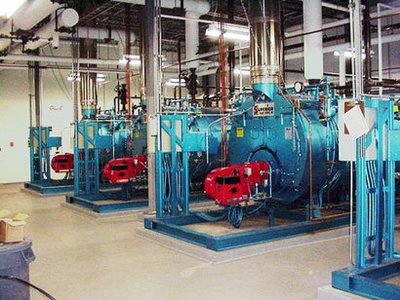
Most companies in the business of treating boilers and cooling towers offer chemical treatment alone. The possibility of removing dissolved minerals as part of the treatment program may not be presented to their customers since it often drastically reduces chemical consumption. However, removing dissolved minerals such as calcium (hardness) feeding a boiler will not only decrease chemical consumption (in the form of scale inhibitors) but will save energy by reducing blow down.
Specifically, boilers evaporate water into steam, leaving dissolved minerals behind in the boiler where they will form damaging scale if allowed to accumulate beyond a certain concentration. Chemical scale inhibitors minimize scaling to a point. However, as the mineral concentration increases, scaling will occur even with proper chemical treatment so water from the boiler is periodically dumped to sewer (blown down) to allow feed water with lower mineral concentration to enter (make-up water). Blown down water is typically 212° to 250° F, so in addition to the cost for water and sewer fees, the energy cost can be very high. When scaling minerals are removed, the need for blowing down the boiler is greatly reduced, significantly saving energy as well as water and sewer costs.
Treating boiler make-up water with reverse osmosis can reduce blow down significantly more since 98% or more of all dissolved minerals are removed. Depending on the size of boiler and operating pressure, amount of condensate returned and mineral content of the feed water, savings can be in the hundreds of thousands of dollars annually. View Reverse Osmosis Savings Article.
Utilization of side stream filters on cooling tower recirculation loops frequently remove many pounds of suspended particles daily. Since suspended solids react with chemicals such as corrosion inhibitors and biocides, filtration sharply reduces the use of these chemicals. Towers also require blow down to keep the dissolved mineral concentration within certain limits or scaling will occur (as water evaporates from the tower, the minerals are concentrated in the sump). Mineral reduction upstream of the tower can often lower the blow down as well as the chemicals required. Recovery and reuse of tower blow down water using treatment equipment is another option.
By offering water treatment equipment as well as chemicals, the WaterProfessionals® are well positioned to thoroughly assess your water treatment requirements. Equipment technologies offered include reverse osmosis, dealkalization, softening, ultrafiltration, nanofiltration, sand and multimedia filtration. Many customers opt to have the WaterProfessionals® own and operate the equipment 24/7 and administer chemical treatment on their premises. Learn more.
Here are some hard data dealing with potential savings from combining a chemical program with equipment:
Energy Savings
Reduced blowdown: By removing dissolved minerals in boiler feedwater, a boiler can operate at much higher “cycles of concentration”, resulting in markedly less blowdown of heated water to the drain. For example, utilization of reverse osmosis treatment of the boiler feedwater in a food processing plant allowed increase in cycles from 10 to 100, reducing blowdown by more than 80% and achieving annual natural gas savings of $299,000.
Chemical Savings
Reduced chemical consumption in Demineralizers: High pressure boilers typically require demineralization of the boiler feedwater to remove minerals that carry over with the steam and plate on turbines (e.g., silica). Demineralizers are typically regenerated with sulfuric acid and liquid caustic. Both chemicals are currently in short supply, subject to unpredictable and rapidly escalating price increases (150% to 300% over 6 months). Some plants and power generating facilities have recently had to purchase on the spot market or have had to utilize emergency mobile DI trailers to bridge between uncertain deliveries.
Utilization of reverse osmosis upstream of the Demineralizers reduces dissolved minerals by 98%, reducing acid and caustic consumption by 90% or more. This list shows typical annual savings, as a function of boiler make-up flow, based on current chemical costs:
100 gpm >$140,000 annually
300 gpm >$260,000 annually
450 gpm >$345,000 annually
These savings typically result in a payback of <15 months.
Ancillary Savings
By removing dissolved minerals in the feedwater instead of relying on chemicals to minimize scaling in the boiler, boiler tubes remain cleaner, resulting in better energy transfer and chemical costs are significantly reduced. Reduced gas or oil consumption, resulting in significant carbon dioxide reduction.
Multiple Ownership Options:
We offer outright purchase and “capital-less” options including lease with purchase option and “vendor owned, vendor maintained” (also known as “own-operate”) options.
Water Solutions Engineering is uniquely qualified by extensive equipment and chemical treatment experience to customize the most economical and effective water treatment solutions for their customers.

